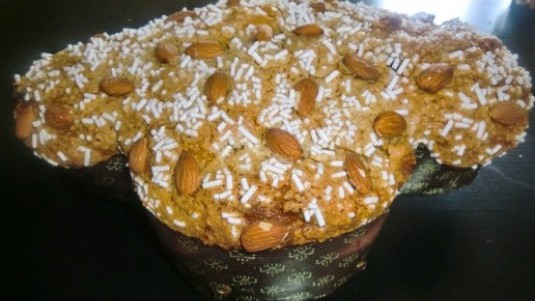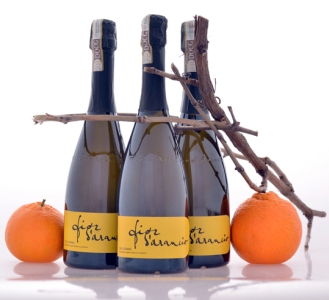Happy Easter with a ‘quick’ Colomba cake

This is a week dedicated to preparations for the Easter feast. Usually, we cook all the food except for the Colomba (Dove), the traditional Easter cake that recalls the symbol of peace and rebirth. So why not take up the challenge and make one yourself at home?
There is no doubt that the traditional recipe using select and genuine ingredients – flour, yeast, eggs, sugar and so on – is not easy so here we offer a quicker version using a beer yeast which you can prepare even the day before Easter and offer everyone the pleasures and aromas of the holiday with the satisfaction of having made the Colomba with you own hands. And it will certainly be much better than any industrially made one.
We suggest it be paired with a Fior d’Arancio Colli Euganei.
Ingredients for a 1kg Colomba:
15g beer yeast, 240g Manitoba flour, 50g water, 10g wheat starch, 130g sugar, 75g milk, 8 egg yolks, 150g soft butter, 5g salt, ½ vanilla stick, 15g acacia honey, peel of ½ a lemon, 1 ungrated orange peel, 3 tablespoons Cointreau, 125g raisins, 1’’g candied orange, 50g candied citron, 75g unpeeled almonds and sugar crumble for the topping.
For the almond glaze icing:
75g peeled almonds, 3 bitter almonds, 75g brown sugar, 3g salt, 25g corn flour, 1 tablespoons Amaretto liqueur, 5 drops almond essence, 50g eff whites ad rice flour as needed.
Directions:
First of all prepare the biga by mixing together in a bowl 50g Manitoba flour with the beer yeast and water and then let it rise covered in seal wrap in a warm environment (for example in an oven that has been heated for one minutes and then turned off with a temperature of around 30°C) for about an hour or until it has doubled in size.
In the meantime, prepare the glaze icing by blending the almonds – which have been dried slightly in the oven – with the sugar, salt and corn flour. Using a whip, mix in the egg whites, Amaretto and almond essence. If necessary, you can thicken it with some rice flour. Conserve the glaze in a refrigerator.
Soften the raisins in warm water for 10 minutes, drain off the water and add a tablespoon of Cointreau for flavor. After about half an hour squeeze dry the raisins and put them in a dish towel to absorb any excess liquid,
Cut the candied fruit into small cubes and keep them aside.
First kneading:
Aside from the biga, keep ready 75g whole milk, 100g (of the 130) of sugar, 15g acacia honey, ½ vanilla stick, 1 ungrated orange peel, ½ lemon peel grated, the rest (200g) of the Manitoba flour, 5 of the 8 egg yolks and 100g (of the 150) of soft butter.
In a kneading machine put the biga dissolved in warmed milk, honey, the seeds extracted from the vanilla stick, the orange and lemon peels. Gradually add in the sifted Manitoba flour and blend until you get a uniform, smooth dough.
Add in the egg yolks one at a time while the machine is in operation and keep blending until the soft dough becomes elastic with a nice gluten shield.
Add the soft butter in pieces little by little making sure the previous piece has blended in before adding the next.
Keep kneading the dough until it is nice and smooth and elastic. Cover the dough with plastic wrap and let it rise for around 90 minutes in an oven pre-heated for a minute to 30°C and then turned off.
Second kneading:
Aside from the previously made dough, keep at hand: 40g Manitoba flour, 10g wheat starch, 30g sugar, 5g fine salt, 2 tablespoons Cointreau, 3 egg yolks, 50g soft butter, 125g raisins, 100g candied orange cut into small cubes, 50g candied citron cut into small cubes, 75g unpeeled almonds and sugar crumble for garnish.
Put the first dough back into the kneading machine together with the flour, wheat starch, sugar, salt and Cointreau and while the machine is in operation add in the yolks one at a time and keep kneading until everything is well-mixed together and is smooth.
Add in the butter in small pieces one at a time.
Mix in the raisins and candied fruit making sure they are well distributed.
Cover the dough and let it rise in a warm environment for around 30 minutes.
Put the dough on a large, flat surface and divided it in two (2/3 for the dove’s body and 1/3 for the wings) and then prepare the paper mold for a 1kg Colomba on a baking pan. Stretch out the dough and put it in the mold in cross shapes. Put the Colomba in an oven that has been heated to 30°C and then turned off and let it rise until the dough reaches the top of the mold (this takes about 90minutes).
Once the dough has risen take it out of the oven and let it sit for around a quarter of an hour. In the meantime, pre-heat the oven to 170°C and using a pastry bag spread the glaze icing on top of the Colomba without letting it get too close to the edges. Even out the icing with a spoon and on top distribute the sugar crumble and unpeeled almonds.
Put the Colomba in the oven and lower the heat to 160°C and bake for around 90 minutes or, if you have a cooking thermometer, until the interior temperature reaches 90-92°C. If the top begins to brown too quickly, cover the Colomba with aluminum foil in final minutes.
After you remove the Colomba from the oven, stick two knitting needles into its sides and let it cool over night upside-down and suspended so it does not touch any surface.
On Easter morning, remove the knitting needles and the Colomba will be ready and fragrant to enliven you table.
Wine to paire:
 Colli Euganei Fior d’Arancio Docg Spumante
Colli Euganei Fior d’Arancio Docg Spumante
There are three types of Colli Euganei Fior d’Arancio (Euganean Hills Orange Blossom), covered by the DOCG regulation: Spumante, Passito and Secco. The classic version, best known to the public at large, is the sparkling wine, or Spumante, with its Doc status since 1994, becoming Docg in 2011. This typical sweet wine of the Euganean Hills just recently has begun to show its potential. Pale gold color, with luscious Mediterranean fragrances, aromas of citrus, bouillon, sage and apricot. Its sweetness is accompanied by an intriguing acidity, and is never sickly. It is this acidity that preserves the aromas, which multiply and become elegant and sinuous in the mouth
Production area: Colli Euganei (Euganean Hills), in Padua province.
Grape variety: Moscato Giallo - locally called Fior d'Arancio (Orange Blossom) - at least 95% with other aromatic grapes.
Wine-making: after harvest, soft pressure of the grapes so that the fruity aroma is enhanced at best, the must then undergoes the sparkling process with Martinotti's method (Charmat).
Suggested food pairing: it goes very well with desserts but has also become a favored aperitif wine or one to sip between meals.

 Italiano
Italiano







